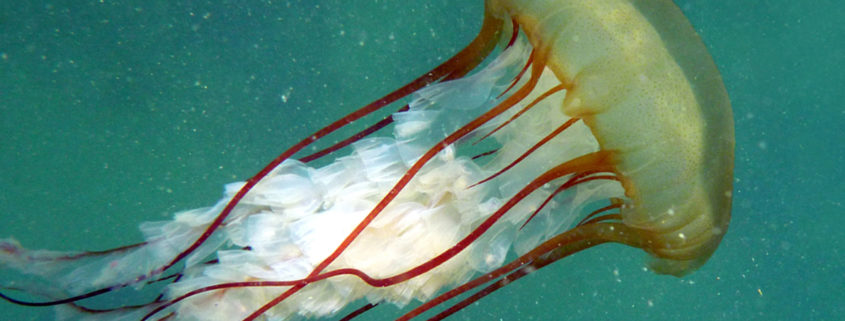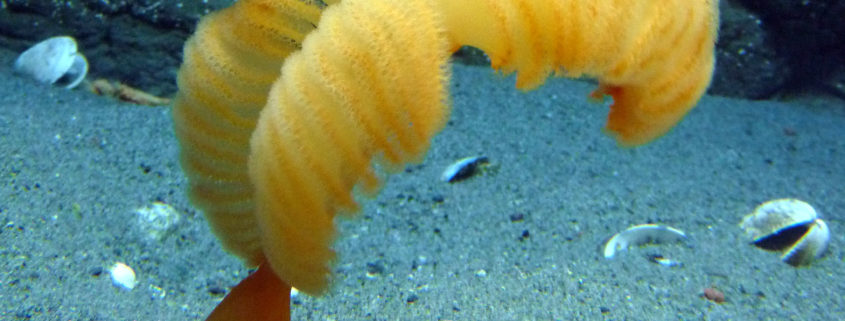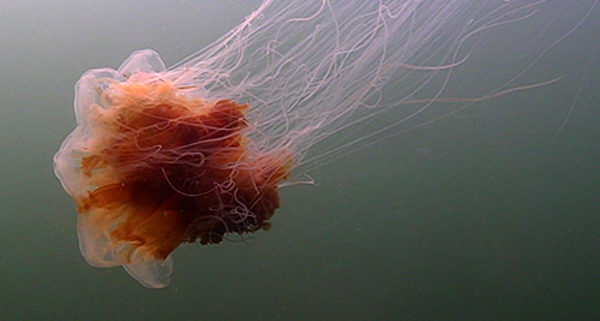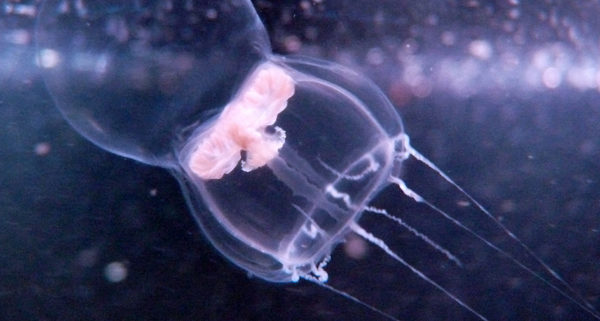Lion’s Mane Jellyfish
Author: Jamie Lenihan
Common name: Lion’s Mane Jellyfish
Scientific Name: Cyanea capillata
Identifying Features:
The Lion’s Mane jellyfish is one of the most easily identifiable varieties of jellyfish. At first glance, you can often recognize one of these jellies by their very large bell size and tentacle length, reaching up to 3 metres in diameter and 130 metres respectively. Depending on their environment, these jellies will grow to different scales: those found in lower latitudes will tend to be smaller, usually only up to a 50cm bell diameter and less than 5 metre tentacle span, while those in Alaska and arctic waters will far more frequently grow to monstrous sizes. A key feature of the Lion’s Mane Jellyfish is the thick red ‘mane’ of tentacles extending from the bell of the creature. These sticky tentacles extend from the centre of the bell, separate from the dull and silver arms that attach to the outer bell. The bell itself is divided into eight distinct regions in a similar fashion to a peeled orange. The jellyfish travels through bell pulsations that propel it forward. The greatest factor in their movement is, however, the ocean current and tides.
Habitat:
The Lion’s Mane habitat ranges all the way from the 50°N latitude in the Pacific and Atlantic Oceans upwards to the Arctic Ocean and surrounding cold waters. These jellyfish prefer to live near the surface of the ocean and rarely travel past 15 metres deep. During most of their lives, the jellyfish will live in the open ocean; it is here that the jelly shares a symbiotic relationship with many other creatures. The jelly gives protection to the smaller organisms as well as providing some of its leftover food. Near the end of its life, the Lion’s Mane Jellyfish drifts towards more sheltered bays and inlets (see the photo below of the beached Lion’s Mane). This is usually a result of their larger size being more naturally affected by current, and not solely by choice. Even when it is washed up on shore the Lion’s Mane can still have active cnidocytes (stinging cells) and should not be handled.
Food and Predators:
Animals that feed on the Lion’s Mane Jellyfish include other jellyfish, large fish, seabirds, and sea turtles – in particular the Leatherback sea turtle. The Leatherback feeds almost entirely on this particular jelly during the summer, particularly in Eastern Canada. Very large Lion’s Mane Jellyfish, such as those in the far north, have very few predators due to their large size; they are seen as ‘not worth the effort’, as their plethora of stinging tentacles makes eating them a challenge. For their own diet, these jellyfish consume mostly very small creatures such as tiny fish, zooplankton, ctenophores, and moon jellyfish. This is done by catching the prey with its netted tentacles.
Life Cycle:
The life cycle of the Lion’s Mane Jellyfish, along with other jellies, is quite remarkable. These jellies have four stages of development over the course of their one year lifespan. The female jellyfish will ferry its fertilized eggs on its tentacles, where they develop into a larval form. Once old enough, the eggs are deposited onto a rock or hard surface. It is here where they develop into a polyp stage. It is through asexual reproduction that these polyps form ‘stacks’ of tiny creatures, known as ephyraes, that break off to later grow into the medusa stage – a full size Lion’s Mane Jellyfish.
Photos by Adam ‘Abcdave’ Davidson (abcdave.deviantart.com) and D. Young (Beached Lion’s Mane)
Read more





